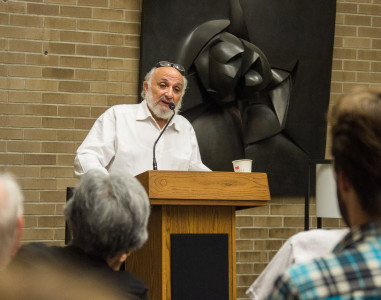Ian Stout
stoutian17@grinnell.edu
Professor Harold Kasimow, Religious Studies, gave a talk last Tuesday, Sept. 29, about the progression of religious tolerance in the Catholic Church.
Kasimow received his Bachelors in Hebrew letters from the Jewish Theological Seminary under Rabbi Abraham Joshua Heschel, then earned his Masters and Ph.D at Temple University. He is an active proponent of interfaith dialogue and was once a member of the Spiritual Life Task Force of the Parliament of World Religions.
Kasimow’s talk examined the Catholic Church’s approach to interfaith dialogue and its evolution in the last fifty years.
He structured his talk around a key declaration in the Second Vatican Council: Nostra Aetate, which bestows a respect for non-Christian religions and encourages all members of the Church to participate in interfaith dialogue.
Kasimow started out his speech by discussing the inspiration of Nostra Aetate. He said that one morning, Pope John XXIII loudly declared to his priests, “I want to throw open the windows of the Church so that we can see out and the people can see in.”
Kasimow then contrasted Pope John XXIII’s declaration with past actions of the Catholic Church.
“There was a Roman Catholic bishop who wanted to celebrate with his Jewish friend but could not simply because as a bishop he could not enter a synagogue … This exclusivist view of other religions became the prevalent Catholic attitude until the Second Vatican Council,” Kasimow explained.
Nostra Aetate marked a key step forward in the Catholic Church’s interfaith dialogue, especially in relation to Judaism. Most importantly, Kasimow explained that the Nostra Aetate discredited the belief that Jews needed to be persecuted for Jesus’ crucifixion.
Nostra Aetate gave similar credit to other religions, declaring that they all share the tenets of “Worship of One God, and the Creator of Heaven and Earth.”
“No one devoted more time or energy to making Nostra Aetate a reality than John XXIII [who] was the first Pope to grant an audience to a Hebrew friend,” Kasimow said.
John XXIII uprooted anti-Semitism by declaring it a sin against humanity. Since then, teaching contempt for the Jews has been officially renounced by the Catholic Church.
Kasimow argues that while John XXIII seemed to embody Nostra Aetate, Pope Francis has also seemed to fulfill the tenets of the document. In the talk, Kasimow explored Pope Francis’s background as a Jesuit, an order that “rejects central authority but has to swear an extra oath of obedience to the Vatican.” He claims that it was both his experience as a Jesuit and a healthy dose of interfaith dialogue that shaped Francis into the Pope he is today.
“Pope Francis will make a great contribution to the interfaith movement because of his deep commitment to interfaith relations as a path to peace with people of other faiths,” Kasimow said.
Kasimow expressed hope at the fact that a religious figure of such high rank was openly pursuing interfaith dialogue. He expressed that the Pope was unique in the fact that “there is no spiritual authority like the Pope in any other religion.” This influence has allowed past Popes to open interfaith dialogue via Nostra Aetate, and this precedent seems to have only grown stronger under the progressive leadership of Pope Francis.































































Angela Winburn • Oct 20, 2015 at 10:33 am
This article is incorrect. John XXIII was before Nostra Aetate and John Paul II was after it.
“No one devoted more time or energy to making Nostra Aetate a reality than” John Paul II. John Paul II “uprooted anti-Semitism” and John Paul II “seemed to embody Nostra Aetate.”